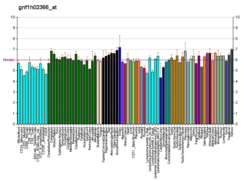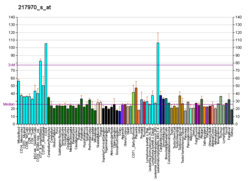| CNOT6 |
|---|
|
| Identifiers |
|---|
| Aliases | CNOT6, CCR4, Ccr4a, CCR4-NOT transcription complex subunit 6 |
|---|
| External IDs | OMIM: 608951; MGI: 2144529; HomoloGene: 69187; GeneCards: CNOT6; OMA:CNOT6 - orthologs |
|---|
| Gene location (Human) |
|---|
 | | Chr. | Chromosome 5 (human)[1] |
|---|
| | Band | 5q35.3 | Start | 180,494,379 bp[1] |
|---|
| End | 180,578,358 bp[1] |
|---|
|
| Gene location (Mouse) |
|---|
 | | Chr. | Chromosome 11 (mouse)[2] |
|---|
| | Band | 11|11 B1.2 | Start | 49,562,330 bp[2] |
|---|
| End | 49,603,550 bp[2] |
|---|
|
| RNA expression pattern |
|---|
| Bgee | | Human | Mouse (ortholog) |
|---|
| Top expressed in | - secondary oocyte
- buccal mucosa cell
- cerebellar vermis
- ganglionic eminence
- ventricular zone
- retinal pigment epithelium
- epithelium of nasopharynx
- trabecular bone
- amniotic fluid
- bronchial epithelial cell
|
| | Top expressed in | - retinal pigment epithelium
- saccule
- otic vesicle
- ciliary body
- ureter
- medial ganglionic eminence
- cumulus cell
- superior cervical ganglion
- trigeminal ganglion
- otic placode
|
| | More reference expression data |
|
|---|
| BioGPS | 
 | | More reference expression data |
|
|---|
|
| Gene ontology |
|---|
| Molecular function | - poly(A)-specific ribonuclease activity
- exoribonuclease activity
- metal ion binding
- protein binding
- RNA binding
- nuclease activity
- exonuclease activity
- hydrolase activity
- 3'-5'-exoribonuclease activity
| | Cellular component | - cytoplasm
- cytosol
- membrane
- CCR4-NOT complex
- nucleus
| | Biological process | - regulation of transcription, DNA-templated
- nucleic acid phosphodiester bond hydrolysis
- transcription, DNA-templated
- positive regulation of cytoplasmic mRNA processing body assembly
- gene silencing by miRNA
- positive regulation of cell population proliferation
- exonucleolytic catabolism of deadenylated mRNA
- gene silencing
- nuclear-transcribed mRNA catabolic process, no-go decay
- regulation of translation
- DNA damage response, signal transduction by p53 class mediator resulting in cell cycle arrest
- RNA phosphodiester bond hydrolysis, exonucleolytic
- nuclear-transcribed mRNA poly(A) tail shortening
| | Sources:Amigo / QuickGO |
|
| Orthologs |
|---|
| Species | Human | Mouse |
|---|
| Entrez | | |
|---|
| Ensembl | | |
|---|
| UniProt | | |
|---|
| RefSeq (mRNA) | |
|---|
NM_001303241
NM_015455
NM_001370472
NM_001370473
NM_001370474 |
| |
|---|
NM_001290741
NM_212484
NM_001363356
NM_001363357 |
|
|---|
| RefSeq (protein) | |
|---|
NP_001290170
NP_001357401
NP_001357402
NP_001357403 |
| |
|---|
NP_001277670
NP_997649
NP_001350285
NP_001350286 |
|
|---|
| Location (UCSC) | Chr 5: 180.49 – 180.58 Mb | Chr 11: 49.56 – 49.6 Mb |
|---|
| PubMed search | [3] | [4] |
|---|
|
| Wikidata |
| View/Edit Human | View/Edit Mouse |
|



















